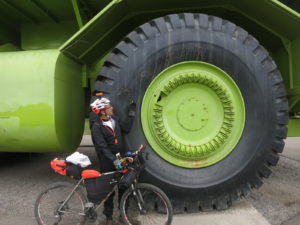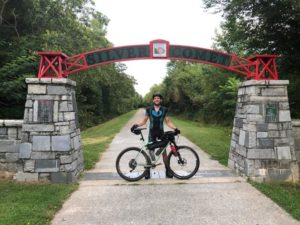About the Super 8 Grand Depart:
The Vermont Super 8 is a bikepacking route that makes a figure 8 through the state of Vermont, with the central node in Montpelier. The route uses as much dirt as possible and features many of the state’s rugged, ancient town highways known as Class 4 roads.
Riders of the Super 8 Grand Depart will start together in Montpelier on Friday, September 27, and have the option of taking on the north “lobe” of the 8 (260 mi.), the south lobe (380 mi.), or the full figure 8 (640 mi.). The rules are consistent with other self-supported bikepacking grand departs or “ultras” that take place around the world. Riders must follow the route and get back to Montpelier under their own power, using only resources that are available to all riders. This includes stopping to resupply at general stores; stopping to rest at public locations; camping in state parks, national forests, or on the grounds of private landowners who have opened their grounds for the duration of the event; and possibly staying in inns or motels. For riders who choose to be timed, the clock runs continuously until they choose to “scratch” or once they return to Montpelier.
About the Contributors to this post:
Zaccur Fettig (Burlington, MA) will be riding in the Super 8 Grand Depart this year, attempting the northern lobe. His experience with bikepacking ultras includes an attempt in the 2018 Tour Divide.
Daniel Jordan (Burlington, VT) serves on the board of directors of Vermont Bikepackers and is an organizer and route curator of the Super 8. His bikepacking ultra experience includes The Adirondack Trail Ride in 2018 and the Trans North Georgia Adventure in 2019.

What you need to get started bikepacking: A plan, a bike, and a mentality.
The plan: Navigating with a GPS device.
Like many bikepacking routes, the Super 8 is available to riders as a group of .gpx files to download onto your bike computer or onto your phone. You mount the device onto your handlebars, load the route, and follow the line. Some bike computers have base maps on them, but this isn’t necessary. Increasingly, riders are choosing to use phones as their primary navigation devices with apps like Gaia or RideWithGPS onto which you can pre-load .gpx files.
ZF: “GPS bike computers tend to have good battery life, low weight and are weatherproof. You can connect heart rate monitors, power meters, cadence sensors, smart trainers and even some action cameras. It’s a good option, with a lot of flexibility. However, navigation is often not as good as it should be, and the computer can be off by several hundred feet at times. A hiking GPS (such as a Garmin eTrex) doesn’t have all the bells and whistles of a bike computer. What it does do is navigation, and it does it well. It’s the most reliable method, short of a map and compass. It’s what most bikepacking racers end up using, just for the reliability.”
DJ: “I second Zac’s take. I usually use a Garmin Edge (cycling computer) that’s >4 years old, and it’s great most of the time, but at times when I have needed high-resolution accuracy — such as trying to navigate tricky intersections or singletrack networks at night — the lack of high-resolution accuracy has been a huge headache and results in lots of frustration and wasted time. I recently got a very basic Garmin eTrex 10, and although it has some limitations, it is dead-on accurate, and has continued to prove reliable. I’ve never used my phone to navigate, and I don’t love the idea of relying on one electronic device for everything.”
The bike: run what you bring.
ZF: “An old mountain bike is a very good starting place. They tend to be built from steel with lugged frames and are very rugged, but a little heavy. They will handle the abuse of riding with an additional 20 to 40 pounds of gear. The only real downside is often the brakes. Depending on where you are, some places have very long, steep descents and rim brakes can overheat leading to warping the rim or bursting a tube. In the Northeast, this is much less of an issue. Rim brakes also wear the rim over time. Often, the most expensive gear is built for racing. For example, a top of the line Shimano XTR cassette has titanium sprockets. Very light, and very expensive: Perfect for racing. However, they wear out incredibly fast (typically on the order of a few hundred miles). One step down, the XT, is exactly the same profile, but in steel and will last for thousands of miles; at 1/3 the cost. Even bottom end components in 2019 are typically very good compared to top end components from a few years ago.”
DJ: “Start with what you have! Ideal starting points are a hardtail mtb with disc brakes, or a gravel bike. You could certainly use your full suspension and be very comfortable, but do you really want to put gear-laden miles on your Yeti? Take a look at the 10-year-old hardtail hanging in your basement: it may have a second life as a bikepacking steed.
For riding the Super 8, a gravel bike is pretty ideal. If you’re running 45c tires or smaller, be ready to hike over rough sections.
As far as upgrades, tires are a big one. Look for a fast-rolling tire with tightly-spaced center knobs and some shoulder knobs. Favorites in Vermont include the WTB Riddler, Panaracer Gravel King SK, Schwalbe Thunder Burt, and Continental Race King. If the option is available to you, go for a tubeless setup, which will help prevent pinch flats as you experiment to find your optimal tire pressure. For riding the Super 8 specifically, the perfect bikepacking tire seems to be at the dead zone of what shops are stocking these days: 700×50, or 29×2.0. Ride as fat as will fit, but keep in mind that a broken spoke causing too much wheel wobble could cause frame rub and render your bike immobile with unless you are prepared to deal with it (using zip ties, a spoke saver, or a new spoke altogether).
Another good upgrade would be to swap out an old suspension fork for a rigid bikepacking fork on your hardtail. There are steel forks for $100-200; the Salsa Firestarter seems to be the gold standard. This gives you the option of adding cages for bags or water bottles on your fork, and it reduces the number of moving parts on your bike, which lowers the risk of things going wrong on the trail. A rigid fork with an mtb tire works well for Vermont routes like the Super 8 or the Green Mountain Gravel Growler, though some riders do prefer suspension forks for added comfort.”
The mentality: Lower your expectations.
“The shortest distance between two points is often unbearable.” – Charles Bukowski
DJ: “Bikepacking means different things to different people, but there are some things that will hold true to anyone who takes on bikepacking in Vermont.
Vermont is extremely hilly. Bikepacking is about finding the hidden and remote corners of the world, and in Vermont, this usually means climbing out of town on an old and rugged road. The higher you climb, the rougher the road gets. Be ready to accept this and do not beat yourself up for having to walk your bike over gnarly class 4 roads.
If Strava says your average speed on a previous gravel ride is 12 mph, great. This does not mean that you can ride 48 miles in 4 hours on a bikepacking trip. If you take a hard look at your stopped time or overall elapsed time, you’ll be surprised at how much time you spend stopping to eat or resupplying — both of which are 100% necessary! Not to mention the fact that you will be taking the most rugged roads on a bike laden with gear. If you are new to bikepacking, 5-8 mph elapsed is a good pace to shoot for on the Super 8. It depends on the route of course.
Be equipped to ride at night, even if that’s not in your plan.
When you arrive at a town, be conscientious — you are dirty and you smell bad — but maintain a good sense of humor. People love being experts about their neighborhoods. Remember that you are visiting and you know next to nothing, so ask questions. How bad is the road over the mountain pass?
There’s a saying that professional bikepacking is amateur homeless. Be ready to feel humbled. It’s okay to ask the gas station attendant to microwave the ravioli that you just poured into the (microwave-safe) coffee cup. It’s storming outside, and you are really hungry. It will be the best ravioli you have ever tasted.”
ZF: “Bikepacking is a fusion of cycling and backpacking. In many ways, it is similar to bike touring, with a major caveat. In bikepacking, much like backpacking, the goal is to carry as little and as light as you can and get where you’re going safely. Bikepacking is most often done off pavement. Some believe it should always refer to off-pavement riding. Some don’t. Some major on-pavement races (such as The Transcontinental or the Trans Am) are basically the same ethos as bikepacking, but on road bikes. Do what works for you.
A few notes to begin with. Wherever possible, start with what you already have. If you have a backpacking tent, a mountain bike or riding shorts; use it. If you need to buy gear, buy it; but you don’t need the best or fanciest to start.
It sounds daunting, but it’s far more freeing than you might think. You don’t have to shoot for an epic ride your first time out. It can be as simple as a ride from your front door to a campground a couple of hours away, stay the night and come back (commonly referred to as a sub-24 overnighter, or s240). The warmer it’s going to be and the shorter the distance, the less you need to carry, so it makes more sense to try your first trip in July than it would in the middle of a blizzard in February; there are people do go out in bad weather too, but it is more difficult.
Go out, and ride your bike. ”

Drinking hot coffee and reading your articles are such a great time. Nice to know you, IDProperti.com | Pasang Iklan Properti
With havin so much content and articles do you ever run into
any problems of plagorism or copyright infringement? My
site has a lot of unique content I’ve either written myself or outsourced but it seems a lot of it is popping it
up all over the web without my authorization. Do you know any techniques to help prevent content from being ripped off?
I’d truly appreciate it.
What’s up, I log on to your blog regularly. Your humoristic
style is witty, keep it up!